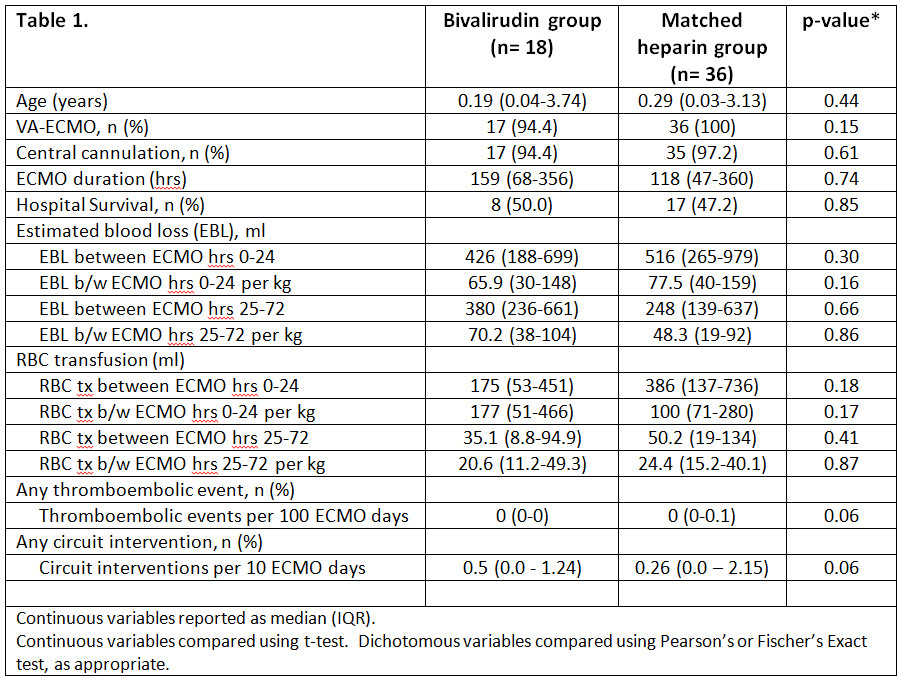NM-373
Observational case-control comparison of Bivalirudin versus heparin anticoagulation for pediatric extracorporeal membrane oxygenation (ECMO).
Yi L, Aganga D, Seelhammer T, Bohman J
Mayo Clinic, Rochester, MN, USA
Introduction: Although there are theoretical advantages of bivalirudin, the effectiveness and risk profile of bivalirudin compared to heparin (the traditional anticoagulant) for extracorporeal membrane oxygenation (ECMO), is currently unknown. An objective comparison of heparin and bivalirudin is necessary to inform further pediatric ECMO anticoagulation practice recommendations.
Methods: Single center, retrospective observational case-control study of extracorporeal membrane oxygenation (ECMO) patients between January 1, 2010 and September 1, 2017. During the study period, an institutional practice change was implemented to allow the use of either heparin or bivalirudin-based anticoagulation for ECMO, which allowed a contemporaneous comparison of the two cohorts. Cases (those who received bivalirudin) were 1:2 matched to controls (those who received heparin) with matching by age (+/- 5 years), VV or VA, number of times sternum accessed (+/- 1), and central versus peripheral cannulation. The primary outcomes compared were survival, and allogeneic blood product use per 24 hours of ECMO. Secondary outcomes compared were blood loss, clinically significant thromboembolic complications (stroke, mesenteric ischemia, pulmonary embolism, and massive circuit thrombosis), and number of ECMO circuit interventions (oxygenator or pump exchange, thrombus extraction).
Results: We identified 18 pediatric ECMO patients managed with bivalirudin and 36 matched controls managed with heparin. The results are displayed in Table 1. The bivalirudin and heparin groups had similar blood loss, thrombotic complication rates, red blood cell transfusion requirements, ECMO duration, required circuit interventions, and hospital survival.
Discussion: Further comparison of dosing adjustments, monitoring and cost are forthcoming. Despite matching, the observational study design is susceptible to selection bias, so ultimately a randomized trial is required. This matched case-control comparison of bivalirudin versus heparin anticoagulation during pediatric ECMO demonstrated similar ECMO blood loss, transfusion requirements, hospital survival, and ECMO circuit interventions.
Conclusions: Markers of bleeding and thrombosis were similar in this single-center matched case-control comparison of heparin and bivalirudin for pediatric ECMO anticoagulation.
References:
1. Weitz JI, Hudoba M, Massel D, Maraganore J, Hirsh J. Clot-bound thrombin is protected from inhibition by heparin-antithrombin III but is susceptible to inactivation by antithrombin III-independent inhibitors. J Clin Invest. 1990;86(2):385-391.
2. Ranucci M, Ballotta A, Kandil H, et al. Bivalirudin-based versus conventional heparin anticoagulation for postcardiotomy extracorporeal membrane oxygenation. Crit Care. 2011;15(6):R275.
Top












